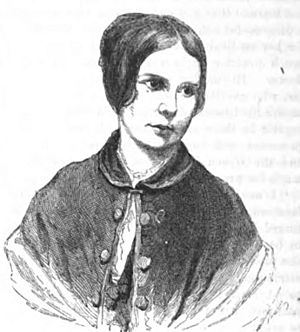Harriet Farley facts for kids
Quick facts for kids
Harriet Farley
|
|
|---|---|
 |
|
| Died | 1907 |
| Occupation | Writer |
Harriet Jane Farley (born February 18, 1812, in Claremont, New Hampshire – died November 12, 1907, in New York City, New York) was an American writer. She was also an abolitionist, meaning she worked to end slavery. Harriet Farley was the editor of Lowell Offering from 1842 to 1845. Later, she edited the New England Offering from 1847 to 1850.
Contents
Harriet Farley's Early Life and Schooling
Harriet Farley was one of ten children born to Reverend Stephen and Lucy Farley. She grew up in Atkinson, New Hampshire. Harriet went to Atkinson Academy, a school for both boys and girls. Her father was the principal of this school.
Harriet Farley's Career Journey
The Farley family was very poor. So, when Harriet was just 14, she started doing "piecework." This meant she earned money for each item she made to help her family. She also worked as a schoolteacher for several years. However, she found that teaching was not her favorite job.
Working in the Lowell Mills
In 1837, at age 25, Harriet left New Hampshire. She moved to Lowell, Massachusetts, to work in the textile mills. These mills made cloth. Many young women who worked in the Lowell mills could read and write well. Many, like Harriet, had been teachers before working in the factories.
It was common for these women to form writing groups. From one of these groups, a magazine called The Lowell Offering started in 1840.
Editing The Lowell Offering
Harriet Farley wrote many articles and stories for The Lowell Offering. She used different pen names. In 1842, she became the editor of the magazine. In 1843, Harriot Curtis, another mill worker, became her co-editor.
Since the magazine was written by and for the mill girls, people had mixed feelings about it. Some, like labor organizer Orestes Brownson, thought the magazine did not focus enough on improving working conditions. Harriet Farley defended her magazine. She said The Lowell Offering was a literary magazine, not a political one.
Despite some criticism, the magazine became very popular. In 1844, a collection of stories from the magazine was published in Great Britain. Even famous writer Charles Dickens noticed it. Mill work was new at this time, so the Offering helped people in Europe understand the daily lives of mill workers.
Harriet Farley's Abolitionist Work
Even though she wanted to keep politics out of her magazine, Harriet Farley joined an important movement. In 1843, she became part of the Massachusetts Anti-Slavery Society. She quickly became an important leader in the fight against slavery in Lowell. As a member, she helped raise money and awareness for the cause.
The End of the Lowell Offering
The Lowell Offering stopped being published in December 1845. Protests about working conditions were growing. The magazine seemed too old-fashioned to its readers. Harriet's popularity also went down. This was because she often defended the factory owners. She kept saying that factory life was fair.
From 1847 to 1850, the magazine was brought back. It was called the New England Offering. Harriet was both the editor and publisher. This new magazine focused more on improving labor conditions than the first one.
Later Writing Career
After moving to New York City, Farley wrote for Godey's Lady's Book. This was a women's magazine edited by her friend Sarah J. Hale. Harriet's newspaper articles were collected into two books in the late 1840s. She also published a children's novel called Happy Nights at Hazel Nook in 1852. She also wrote Shells from the Strand of the Sea of Genius, a book of religious essays. She also edited a book about theology written by her father.
Harriet Farley as a Writer and Editor
After working as a weaver in Lowell textile mills, Farley started writing for the Lowell Offering. This was a monthly magazine, 32 pages long. It was published from 1840 to 1845 and had over 50 women writers. The Lowell Offering started from a writing group for working women. This group met at the Second Universalist Church.
The magazine published poetry, articles, and personal essays. It gave working women in the Lowell textile mills a chance to share their writing. Working on the Lowell Offering helped women continue their education while working. The magazine wanted to show that working women could be smart and thoughtful. This idea was different from what many people in Europe thought about mill workers.
As the magazine grew, the writers became very proud of it. Many famous authors, like Charles Dickens, praised the Lowell Offering. The magazine stopped publishing for a short time in 1845.
In 1847, Farley started the magazine again. She called it the New England Offering. She wanted to include writings from even more women. In April 1848, she became its publisher and traveling agent. Farley hoped the New England Offering would be as popular as the first one. Sadly, it did not have the same success. It only lasted for two more issues.
Both the New England Offering and the Lowell Offering were places where working women could share their stories. For the first time, Farley created literary magazines where working women could publish their writings. She made sure the quality of the writing was very high.
Harriet Farley's Personal Life
In 1854, Harriet married John Intaglio Donlevy. He was an engraver and inventor from New York. For the next 20 years, she stopped publishing books and raised five children. After Donlevy passed away, she published a Christmas book called Fancy's Frolics in 1880.
Harriet Farley died in New York City in 1907. She was 95 years old.
Harriet Farley's Published Works
- Shells from the Strand of the Sea of Genius, 1847
- Mind Among the Spindles, 1849
- Happy Nights at Hazel Nook, 1852
- Fancy's Frolics, 1880

